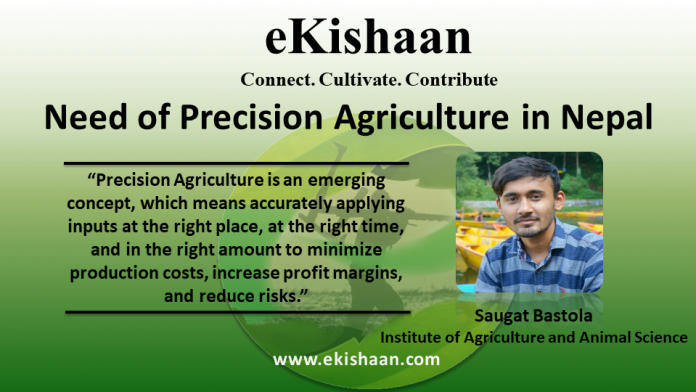Need of Precision Agriculture in Nepal
Nepal being the agricultural country, where directly or indirectly 80 percent of individuals are engaged in agricultural ,occupying 4 million hectares of Cultivable land (30% of the total land), 54% of irrigation land, and 4 million hectares of forest (30% of the total land) where 39% of Country’s GDP from Agriculture, 65% people derive livelihood from Agriculture. Although Nepal’s overall agricultural imports continued to grow, it created a record of NRs. 250 billion in 2019-20. Rice accounted for 22.23 billion rupees, followed by corn, which accounted for 14.75 billion rupees of total cereals imports.
Despite being a large agricultural country, Nepal ranked 73rd among 117 eligible countries in the 2019 Global Hunger Index (GHI).Therefore, have you ever thought that, although we have great potential and energy in production, we cannot maintain food security in our own country, so what we want is a revolutionary change in agriculture, which can be achieved through precision agriculture.
Precision agriculture (PA) referred to as a satellite farming or site-specific crop management (SSCM) system based on information and technology that analyses the spatial and temporal variability within the field and addresses them consistently for optimizing productivity, profitability, and environmental sustainability. It is an emerging concept, which means accurately applying inputs at the right place, at the right time, and in the right amount to minimize production costs, increase profit margins, and reduce risks.
On the one hand, the method defines the requirements for crops and soil to achieve optimal productivity, and on the other hand, it is to protect resources and ensure environmental sustainability and protection. Spatial images and interpretation tools enable farmers to accurately distinguish problem areas, decide which method to use in the target area and calculate the best time. The process of entering precision farming helps to solve the most critical problems in agriculture: waste of resources, high cost and destructive environmental impact.
The basic tools that are used for precision agriculture are:
Global Positioning System (GPS) which can provide free 3D location data (latitude, longitude and altitude) at any time and in any weather, with an accuracy of 100 to 0.01m.
Geographical Information System (GIS), which can import, export and process spatial and temporal geographically distributed data and store it.
Variable-rate Technologies (VRT) that has ability to apply the precise and variable amount of inputs in the right place, at the right time according to the exact variation in the plant growth, soil type, and nutrient status.
Remote sensing that is used to collect data from a distance to assess the health of soil and crops, and help to distinguish crop types, locate plants affected by pests and diseases, and monitor stress, soil, plant and drought conditions.
Similarly, Mapping , Proximate sensors , Automated steering system, Robots, Drones are tools used in precision agriculture.
As we all know, Nepal’s population is growing at an alarming rate, so as the demand for food is also growing and at the same time food productivity is at threat due to climate change, population pressure, uneconomic landholdings, decreasing agricultural lands, etc. Today, the food production system is facing tremendous changes, and in the coming days, such changes will indeed increase. The future of agriculture will rely heavily on knowledge, competition and market driven. Due to the increase in population, the horizontal expansion of land is impossible. This situation requires the use of modern agricultural methods (such as precision agriculture) to increase food production on existing agricultural land. The economic and environmental benefits of agriculture can be improved through the precise application of inputs. The entire field can be managed based on site specific differences, rather than hypothetical averages that may not exist everywhere.
In order to increase agricultural production and diversify the agricultural base, the government has focus on irrigation, the use of fertilizers and pesticides, and varieties till now. However, the expected output is unsatisfactory. Therefore, with the help of “precision agriculture”, agriculture can be automated, the collection and analysis of field information will be simplified, and can protect soil and environmental quality. It allows site-specific management decisions to be made and succeeded in a small area within a larger field to optimize production efficiency and quality. Drones calculating final crop numbers and unmanned bots taking care of weeding are two key examples of precision agriculture. Currently, some private companies in Nepal are using precision agriculture technology because it requires a strong IT infrastructure and resources for monitoring. However, smaller farms and cooperatives can use mobile devices and crowd sourcing to optimize their agriculture. Therefore, with this information, farmers can better make wise decisions on farm management, purchase decisions and resource allocation decisions. Thus it is simplified, improved ,more cost efficient farming process which can address all agricultural and environmental issues in Nepal.
For a country of its size, Nepal has tremendous geographic and climatic diversity. Within the distance of 800km(east to west) and 150 to 250 km(north to south) ,it is endowed with varied biodiversity and climate and has huge potential for boosting agricultural production and the economy of the country as a whole. So, there is a great need for the adoption of precision agricultural practices for the upliftment of productivity. Although It is a technically sophisticated system and requires great technical knowledge for successful adoption and implementation but with the development of the knowledge needed to guide the new technologies farmer can quickly adopt it. Assistance from the government and the private sector and training on the use of modern technology and equipment are necessary conditions for the development of precision agriculture in Nepal.
About the Author:
Saugat Bastola; B.Sc. Ag
Lamjung Campus
Institute of Agriculture and Animal Science
You may like:
Organic Coffee production in Nepal: Status and Opportunities


[…] Need of Precision Agriculture in Nepal […]